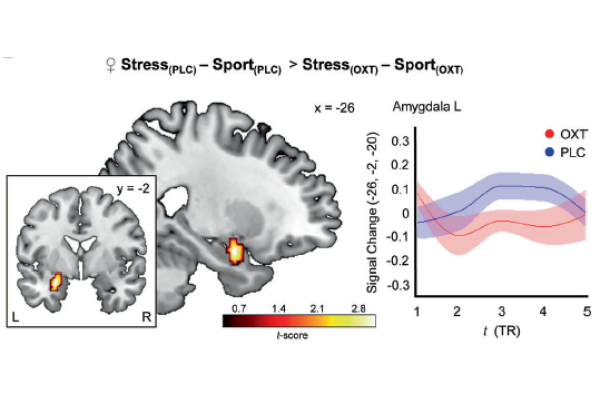2018-04-12

Do you know the smell of fear? Did you know that anxious individuals exhibit heightened sensitivity towards stress signals that they smell in sweat? But can oxytocin, a hormone that is associated with social affiliation, diminish behavioral and neural responses to social chemosensory stress cues? To provide an answer to this question, social neuroscientists from Bonn and biopsychologists from Bochum tested subjects in a forced-choice emotional face recognition task with neutral to fearful stimuli while they were exposed to both sweat stimuli and control odors following intranasal oxytocin or placebo (PLC) administration, respectively. Beforehand, axillary sweat had been obtained from healthy male donors undergoing the Trier Social Stress Test (stress) and bicycle ergometer training (sport). On the neural level, oxytocin reduced stress-evoked responses in the amygdala. It also reinstated the functional connectivity between the anterior cingulate cortex and the fusiform face area that was disrupted by stress odors under placebo. These findings open the door to a completely new role for oxytocin in the modulation of chemosensory stress communication. Mechanistically, this effect appears to be rooted in a downregulation of stress-induced limbic activations and concomitant strengthening of top-down control descending from the anterior cingulate cortex to the fusiform face area.

Do you know the smell of fear? Did you know that anxious individuals exhibit heightened sensitivity towards stress signals that they smell in sweat? But can oxytocin, a hormone that is associated with social affiliation, diminish behavioral and neural responses to social chemosensory stress cues? To provide an answer to this question, social neuroscientists from Bonn and biopsychologists from Bochum tested subjects in a forced-choice emotional face recognition task with neutral to fearful stimuli while they were exposed to both sweat stimuli and control odors following intranasal oxytocin or placebo (PLC) administration, respectively. Beforehand, axillary sweat had been obtained from healthy male donors undergoing the Trier Social Stress Test (stress) and bicycle ergometer training (sport). On the neural level, oxytocin reduced stress-evoked responses in the amygdala. It also reinstated the functional connectivity between the anterior cingulate cortex and the fusiform face area that was disrupted by stress odors under placebo. These findings open the door to a completely new role for oxytocin in the modulation of chemosensory stress communication. Mechanistically, this effect appears to be rooted in a downregulation of stress-induced limbic activations and concomitant strengthening of top-down control descending from the anterior cingulate cortex to the fusiform face area.